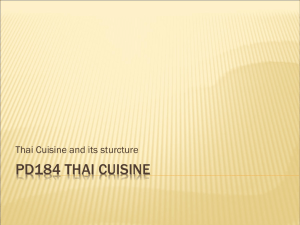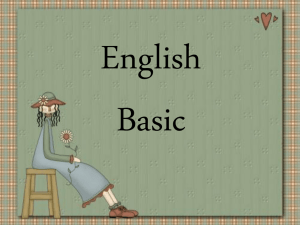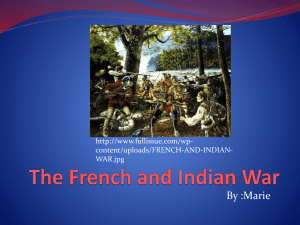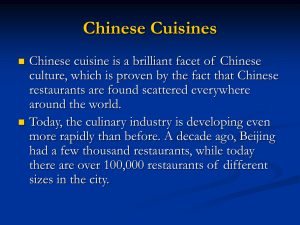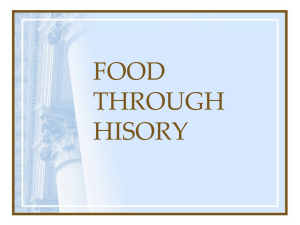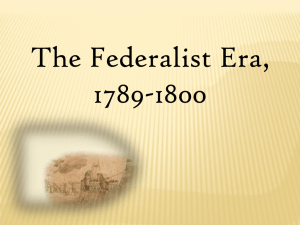Historical Banqueting
advertisement
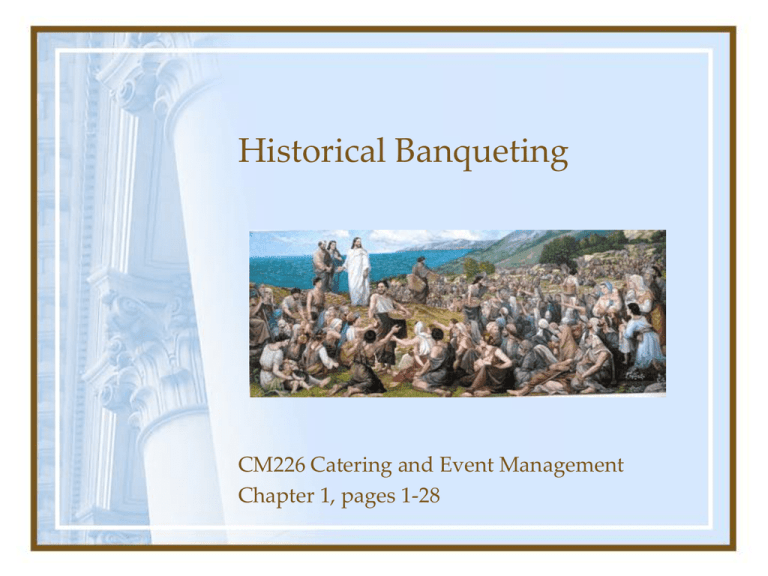
Historical Banqueting CM226 Catering and Event Management Chapter 1, pages 1-28 CHAPTER OBJECTIVES • Explain the development of the banquet menu. • Explain the transformation of the menu to the nine course format • Describe how European banqueting is reflected in American banqueting. CHAPTER OBJECTIVES • Discuss how Thomas Jefferson aided in the development of American banqueting. • Explain how Jacqueline Kennedy influenced American banqueting. Part I INTRODUCTION / BANQUETING The beginning of catering profession started in ancient civilizations • Egyptians filled their tombs with foodstuffs and cookware to supply then in the next world • Egyptians also covered their walls with murals depicting food preparation and table settings. • Art records of Greeks and Romans include depictions of banqueting, table customs, decorative arts and recipes • Written records of the Greeks and Romans focus on specific types of food eaten rather than the entire meals. 5th Century – Apicius • Apicius is the title of a collection of Roman cookery recipes, usually thought to have been compiled in the late 4th or early 5th century AD and written in a language that is in many ways closer to Vulgar than Classical Latin. “Cooking &Dining in Ancient Rome” • Is a written collection of recipes dating back to 42 BC and AD 37. • Greek banqueting featured hors d’oeuvre trolley, and a number of small portion dishes. Middle Ages • The Middle Ages of European history are a period in history which lasted for roughly a millennium, generally dated from the fall of the Western Roman Empire in the 5th century to the beginning of the Early Modern Period in the 16th century. Middle Ages (continued) • This period is marked by the division of Western Christianity in the Reformation, the rise of humanism in the Italian Renaissance, and the beginnings of European overseas expansion. Part II THE BANQUET HALL. Medieval Period • The roots of modern banqueting extend from the Medieval period • 13th century meal service instructions for serving • Food Preparation Methods • The three course menu outline Part III RENAISSANCE EUROPEAN BANQUETING. • The Renaissance meaning "rebirth” was a cultural movement that spanned roughly the 14th to the 17th century, beginning in Italy in the Late Middle Ages and later spreading to the rest of Europe. • As a cultural movement, it encompassed a rebellion of learning based on the classical sources, the development of linear perspective in painting, and gradual but widespread educational reform. • The age of enlightenment. • An intellectual transformation resulted in the Renaissance being viewed as a bridge between the Middle Ages and the Modern era. • The Renaissance saw revolutions in many intellectual pursuits. As well as social and political upheaval, it is perhaps best known for its artistic developments and the contributions of such polymaths as Leonardo da Vinci and Michelangelo, who inspired the term "Renaissance man". Henry VI’s marriage to Jon of Navarre • This menu featured a sotelte with each course. • Sotelte were food sculptures and showpieces. • Montees of he 18th and 19th centuries were later versions of sotelte. Part IV EIGHTEENTH-CENTURY BANQUETING. • By 1727, the banquet menu had been abridged to two main course settings. • The third course was reduced to fruits, nuts, etc. • The menu changes in the 18th century became the foundation of the twentieth-century banquet menu. Part V NINETEENTH-CENTURY MENU REVISIONS. • By 1867, the number of menu items underwent a sharp reduction and was separated into menu categories. 19th Century Classic Nine Course Format • • • • • • • • • First Course second Course Third Course Fourth Course Fifth Course Sixth Course Seventh Course Eighth Course Ninth Course • • • • • • • • • Soup Hot hors d’oeuvres Cold hors d’oeuvres Intermediate fish course Intermediate meat, poultry or game Entrée Rotis Salad Entremets (dessert) • Missing from this menu is the traditional cheese course that, when served, preceded the sweet course. • During this time, European menu presentation continued to heavily influence the United States. Part VI NATIVE AMERICAN FEASTS. • Feasts are an American tradition dating back to social ceremonies of the Native Americans. • A ceremonial feast of the tribes in the American Northwest is called a potlatch. • This ceremonial feast was used to mark important occasions such as a marriage, or the succession to chieftainship. • As a sign of conspicuous wealth, the customs of a potlatch required the host to provide the best quality foods available in quantities too great to be eaten by the number of guests. • The host of the potlatch was also expected to give away a fortune in gifts. Part VII THE COLONIAL PERIOD. • Pre-revolutionary cuisine and the patterns in which meals were served primarily followed English custom. • The menu pattern for formal meals was offered in two courses, each a complete meal in itself. Part VIII NINETEENTH-CENTURY BANQUETING. • The traditions of American colonies were continued in menus. • The menu continued to follow a classic format. • This included a variety of Native American foods and traditional New England cooking is apparent during this time. • The influence of the three-course menu is still evident in the presence of the relish course and the fruits and nuts in the dessert course. • There was, however, more emphasis on heavy dessert section. Part IX AMERICAN PRESIDENTIAL BANQUETING. George Washington • This was America’s first opportunity to entertain the world stage. • Meal formats continued to follow three-course patterns still popular in Europe. • The third course was offered after the tablecloth was removed. • Decanters of port, cheeses, nuts and fruit were placed on the table. • Menus from this period indicated diversity and availability of food products in the mid-Atlantic region. Thomas Jefferson • Thomas Jefferson had a great influence on the development of banqueting styles in America. • As President, he established a pattern of elegant banquets featuring French cuisine an the best wines available. • The banqueting style Jefferson brought to America was cuisine bourgeois, a simplification of the heavy, three-course meals held over from the Middle Ages and used in Europe through eh eighteenth century. • Similar to the twentiethcentury modifications to French cuisine, know as novelle cuisine, these changes were a reaction to the rich stocks, sauces of the eighteenth century. • Jefferson's contributions to American cuisine include inc cream, vanilla, pasta and tomatoes. • Jefferson’s fascination with French cuisine extended to the equipment used to prepare and serve it, and he purchased a large quantity of cookware and bake ware in Paris. John Quincy Adams • Adams was known more for receptions that included coffee, tea, variety of cakes, jellies, icecream, West Indian fruit, and white and red wine, and sometimes other cordials and liquors. • Everything was butlered by servants (served on large trays). John Tyler • Similar to Jefferson, Tyler favored informality blended with fine cuisine. James Buchanan • Buchanan is known best for having brought formal elegance of European society back into the White House. Abraham Lincoln • Lincoln’s inaugural ball reflected the diverse cuisine styles of the first 100 years of the American presidency, combining the nation's bounty of foods which had been present at Washington’s table with the influence of French cuisine. Ulysses S. Grant • Grant’s menus embodied the marriage of American cuisine and traditional French dining customs. • Grant often served a combination of American foods in the classical French format, accompanied by an appropriate wine for each course. Franklin Delano Roosevelt • Roosevelt served informal American cuisine. The Kennedy Era • Next to Thomas Jefferson, Jacqueline Kennedy had the most significant influence on the style of banqueting in the White House. • Her personal interest in the quality and style of cuisine and service for White House functions changed the patterns followed in previous presidencies. Mrs. Kennedy dramatically changed the menu format, reducing the number of courses from seven to four or a maximum of five. • The change of simple elegance reflected contemporary dining trends and reduced the overall dining time, allowing more time for evening entertainments that became the hallmark of the Kennedy presidency. Fini.

